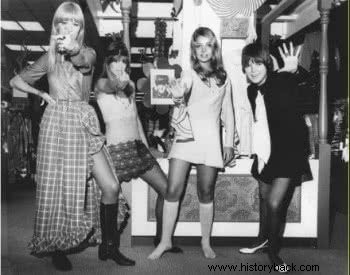The 1960s was characterized by the strengthening of left-wing movements in Western countries, both politically and ideologically.
At that time, there was an unfolding of alternative cultural and ideological projects launched during the 1950s. This is the case of the explosion of consumption caused by the prosperity of rich countries.
Culture and Society
On the cultural plane, the counterculture movement will dominate. The emergence of feminism and civil movements in favor of blacks and homosexuals will set the tone for the claims in the following years.
This is how movements like the hippies, opposed to the Cold War and Vietnam, emerged to lead the pacifist ideals of the time.
A set of demonstrations appears in several countries. These manifestations stem from the movements for blacks (black power ), the gay movement (gay power ) and for equal status between the genders (women's lib ).
Unsurprisingly, the rebelliousness of the 60s reached its peak in 1968 when several movements students across the globe take to the streets to contest the prevailing society.
Music
The Beatles and The Rolling Stones are the music icons of the 60s, while Bob Dylan represents protest music.
In Brazil, Elis Regina inaugurated Música Popular Brasileira (MPB) in 1965, when she interpreted Arrastão, by Vinícius de Moraes and Edu Lobo. The movement is consolidated at TV Record's Brazilian Popular Music Festival.
Two years later, in 1967, Tropicália appeared, by Caetano Veloso and Gilberto Gil and Os Mutantes, with Tom Zé and Torquato Neto.
The Jovem Guarda dictated the costumes and was successful on television.
See also about:Origin of Funk
Fashion

The behavior of society has undoubtedly influenced fashion. So, that's when unisex clothes appear. An example of this is the tuxedo female.
The miniskirt , however, is the main brand of the 60's.
Other characteristic models of the 60's are the tubes, space-style clothes and white high-top boots.
Learn more about Feminism in Brazil.
Television and Film
Another important fact of this decade is the worldwide diffusion ofcolor TV . In Brazil, TV Tupi broadcasts its first color broadcast on May 1, 1963.
On April 26, 1965, Rede Globo de Televisão was inaugurated in Rio de Janeiro. European cinema gained strength with the Nouvelle Vague , especially with the films of Jean-Luc Godard and Glauber Rocha's new Brazilian cinema.
The film "2001:A Space Odyssey" by Stanley Kubrick , from 1968.
Technology
From a technological point of view, this is the era of using computers for commercial purposes, with the launch of IBM's RAMAC 305 (the first electronic computer).
In 1964 IBM launches with an integrated circuit (chip). To complement this, the prototype of the Internet appears:the Arpanet.
Discover the History of the Internet.
On the other hand, the technological dispute between the USA and the USSR continues. The Soviets send the first man into space (Yuri Gagarin , in 1961) and the Americans, the first man to walk on the moon, in 1969 (Neil Armstrong).
See also:Man's Journey to the MoonPolicy
Regarding the symbolic aspects, we can highlight the construction of the Berlin Wall in August 1961.
In geopolitical terms, June 5, 1967 was marked by Israel's attack on the forces of Syria, Egypt and Jordan, initiating the Six-Day War.
In Brazil, the city of Brasilia is inaugurated on April 21, 1960, the new capita. The following year, João Goulart became the first Labor President, but was deposed by the 1964 Military Coup, which inaugurated a new dictatorial period in Brazilian history.
Economy
The economy in the 1960s was characterized by a worldwide slowdown and the end of the golden years of capitalism. Despite this, countries like Japan show high growth rates.
In Brazil, the industrialization process it deepened even more, especially after the construction of Brasília on the Central Plateau. Investments in infrastructure will seek interconnections between the capital and other regions of the country.
On the other hand, São Paulo was the economic hub around which the new industry was organized, despite the economic miracle already showing signs of bankruptcy.
Now that you know all about the 60's, read the 50's and 70's.
